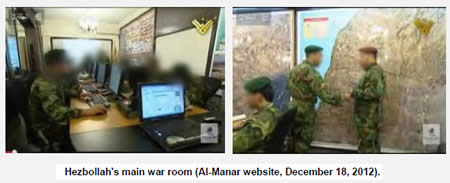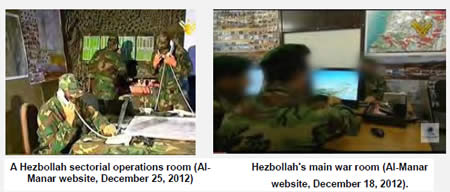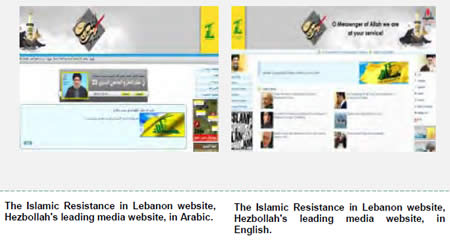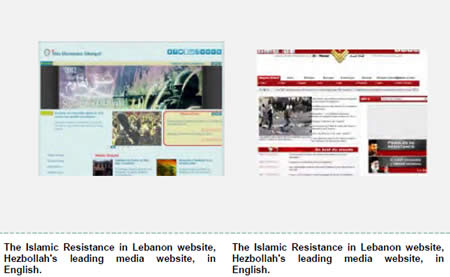Overview
1. For Hezbollah, its cyberspace presence is of great importance, and is considered by both Hezbollah and Iran as an important weapon in the battle for hearts and minds. Hezbollah and Iran use the Internet for both internal information and indoctrination (in Lebanon, the Shi'ites and its own operatives) and external pro-Iranian propaganda (especially the Arab-Muslim world and the West). The network enables Hezbollah to circumvent the limitations placed on its other media (television, radio, the press) by the West, especially the United States.
2. Today Hezbollah's vast media network includes a satellite television channel (Al-Manar TV), a radio station (Radio Nur), the press (Al-Ahad/Al-Intiqad) and network of websites. Hezbollah also uses the social networks, YouTube and various Lebanese media which it does not own but which are affiliated with it, to publicize its positions and policies (for example, the newspaper Al-Akhbar and the Al-Mayadeen TV channel).
3. During the past decade Hezbollah developed an extensive Internet presence, much larger than those of the other terrorist organizations. Since the Second Lebanon War (2006), and with greater intensity during the past year, Hezbollah has increased its Internet presence, improved its quality and upgraded it technically. Currently (updated to March 2013) Hezbollah has more than 20 websites in seven languages, some of them news sites and some of them relating to specific issues. The sites are used by senior Hezbollah figures, the organization's social institutions, its media and several important Shi'ite villages in south Lebanon where Hezbollah is entrenched.
4. From the point of view of a terrorist organization like Hezbollah, developing and maintaining such a broad Internet network in particular and its media empire in general is very expensive. It also necessitates technical capabilities and trained manpower. In our assessment, Iran supports the development and maintenance of Hezbollah's Internet presence and media empire, which exceed, both in extent and capabilities, Hezbollah's needs in Lebanon per se. In addition, Iran itself operates two Farsi websites devoted to Hezbollah.
5. The propaganda and information strategy of Hezbollah's websites is uniform, and both serves the organization and promotes Iran's ideology and political agenda. In our assessment, media strategy is formulated by Hassan Nasrallah and the Hezbollah leadership, based on overall Iranian strategy. Hezbollah's media policy is coordinated with Iran, whose policies and considerations are well known to senior Hezbollah figures.
The Main Themes of Hezbollah's Websites
6. The main themes of Hezbollah's websites are the following:
1) Glorifying the organization, representing it as a force gaining in strength while Israel is represented as growing weaker and about to collapse: That includes messages of deterrence for Israel, which also serve Iranian strategy. Such messages were more conspicuous during the past year, resulting from the open discourse between Israel and Iran regarding the international sanctions imposed on Iran.
Glorifying Hezbollah: Scenes from a 17-part Al-Manar TV documentary entitled "What if Hezbollah were defeated," broadcast beginning December 17, 2012


2) Fostering the personality cults of Hezbollah leader Hassan Nasrallah and of Hezbollah shaheeds, represented as heroes and role models. The three principle shaheeds commemorated by the organization are Sheikh Gharb Kharb, Sheikh Abbas Musawi and Imad Mughnieh.
3) Legitimizing terrorism towards Israel and the West by cultivating the ideologies of shahada (death as a martyr for the sake of Allah), muqawama ("resistance") and jihad; at the same time, there is strong condemnation of any Arab or Palestinian peace process and the agreements or arrangements with Israeli they might produce.
4) The hate industry: Vicious propaganda and incitement against Israel, the Zionist Movement, the Jewish people, the United States and the West. Hezbollah rejects the existence of the State of Israel, calling for its annihilation and the establishment of a Palestinian state on the ruins.
5) Disseminating Iranian Islamic Shi'ite ideology based on the principles set down by the Ayatollah Khomeini, including hatred for the United States, the West, Israel and the Jewish people. Hezbollah websites also promote the personality cult of Iranian Supreme Leader Ali Khamenei, representing Hassan Nasrallah as one of his supporters and admirers.
6) Promoting Hezbollah and Iran's political agenda: Hezbollah's websites support Iranian policy in the Middle East and its positions concerning the United States and the West. They also foster the "resistance camp," which includes Iran, Syria, Hezbollah and the Palestinian terrorist organizations. During the past year Hezbollah's media, including its websites, were enlisted in a propaganda campaign to support the Assad regime in Syria it defaming and criticizing the Syrian opposition and the popular uprising.
Hezbollah's Target Audiences
7. The main target audience of Hezbollah's websites is Lebanon, especially the Lebanese Shi'ite population. Hezbollah wants Shi'ite support and to recruit its members as fighters in its ranks. Another important target audience is Iran. In our assessment, its second priority is the Arab-Muslim world, whose support it also needs. Third in importance are the West and Israel, especially their Arab-Muslim communities (exposed to anti-Israeli and anti-Western as well as pro-terrorism incitement through Hezbollah's websites).
8. Hezbollah's websites appear in seven languages, the most important of which is Arabic, the language of the Lebanese and Arab target audiences. Until recently, they appeared in Arabic, English, French, Farsi and Hebrew;[2] Azeri and Spanish have lately been added. Their addition indicates the importance Iran and Hezbollah give Azerbaijan and Latin American countries (in which there are large Arab-Muslim communities, especially Lebanese communities). Thus, through Hezbollah's Internet network, Azeri and Spanish-speaking populations are exposed to anti-West, anti-Israeli and pro-terrorism incitement, with Iranian orientation.
Examples of Hezbollah Website Homepages


The Popularity of Hezbollah's Websites
9. Despite the efforts Iran and Hezbollah have invested in launching and developing the Hezbollah website network, most of them received relatively low ratings in a survey conducted of Lebanese news sites. According to the global web metrics provider Alexa.com, the only Hezbollah website enjoying high ratings the Al-Manar TV website, which in 2012 was rated second of the ten most popular Lebanese news sites (after Tayyar, the site of the Free Patriotic Movement, Hezbollah's opposition in Lebanon. In eighth place was the website of the newspaper Al-Akhbar, affiliated with – but not owned by – Hezbollah).
10. Most of Hezbollah's websites, especially those belonging to its social institutions, are not particularly popular in Lebanon and especially not beyond its borders. In our assessment that is because most of its visitors are Shi'ites (the largest community in Lebanon), who visit them because of their religious/sectarian slant and because of their clearly Iranian orientation. On the other hand, most other communities, which are are hostile to Hezbollah (and its Iranian and Syrian sponsors), prefer websites which do not identify with Hezbollah and Iran's political and ideological agendas.
11. Hezbollah operates in a number of ways to break through the constraints of its religious-sectarian-political identity. For example, it makes use of Lebanese media such as Al-Mayadeen TV and the newspaper Al-Akhbar, which are affiliated with but not owned by Hezbollah. In some instances Hezbollah tries to blur the identity of some of its websites and attempts to represent them as overall-Lebanese or at least generally Shi'ite. Another marketing tactic is the large number of languages used by Hezbollah to appeal to Arab-Muslim communities around the globe, especially those in the West and in Latin America.
Results of a Technical Analysis of Hezbollah Websites[3]
12. Most of Hezbollah's websites receive technical support from Internet companies in the United States, Europe (Britain, France) and Lebanon. They provide Hezbollah with IP addresses and/or access to the Internet. In our assessment, most of the time the Internet service providers (ISPs) are approached by front men or by Internet companies, usually from Beirut, which not necessarily affiliated with Hezbollah. They are then listed as contact personnel for a number of websites (For further information see below). In addition, as opposed to past practice, Hezbollah's websites frequently change their IP addresses and ISPs (almost every year), and each of them has addresses with various extensions (.org, .com, .net).
|
13 In our assessment, using front men and Lebanese Internet intermediaries, like frequently changing ISPs, has three objectives: the first is to blur, insofar as is possible, Hezbollah's ties to the websites and prevent the ISPs from connecting it to them. The second is to make if difficult for the authorities in the United States and other Western countries to shut the sites down (the United States is especially problematic for Hezbollah, where Hezbollah is designated as a terrorist organization and where in the past law enforcement authorities used measures against Hezbollah media). The third is to prevent cyber attacks. The Palestinian Islamic Jihad, which maintains close relations with Iran, uses similar tactics to make it difficult to identify its websites.[4] |
14. Two important websites do not hide their Iranian identities: Moqawama.ir is a Farsi site and is registered to the owner of an Internet company in Mashhad, who is head of the culture and communications department of the Islamic information ministry in the province of Razavi Khorasan, in northeastern Iran. The website is devoted in its entirety to Hezbollah and Lebanon. It may be officially or semi-officially run by the Islamic Information Organization in Iran and promotes Hezbollah's image in Iran. Another Iranian website is moqavemat.ir, registered to a man living in Iran (in Qom, and in the past in Mashhad); its IP is with a company in Qom. It mostly posts articles about Iran, combined with relatively scanty coverage of Hezbollah. In our assessment, the website is also operated by Iran to promote Hezbollah's image.
15. Most of Hezbollah's websites are interactive: Programs broadcast by its radio station, Al-Nur, can be heard on its website; Al-Manar TV broadcasts can be viewed, and its newspapers and magazines can be read in PDF format. Moreover, Hezbollah uploads propaganda videos to YouTube, has a Facebook page and a Twitter account, some of its sites have RSS feeds and others can be downloaded to smart phones.
16. The graphic design of Hezbollah's websites has improved in recent years and there are links to the social networks. In particular, the graphics of the news websites are more professional.
Main Findings of the Analysis of Hezbollah's Websites
17. Hezbollah websites can be divided into seven general categories according to the functions they serve:
1) Category 1 – Main news sites: Hezbollah's leading news site is Al-moqawama al-islamiyyah fi-lubnan ("the Islamic resistance in Lebanon"). It also has other news sites, among them Moqavemat ("resistance")wa-inbaa ("news") and Daam al-moqawama al-islamiyya fi-lubnan ("Support for the Islamic resistance in Lebanon) (which can be accessed through a link in Hezbollah's Qawem forum). There was also a now-defunct news site called Wa'ad ("promise"). The category also includes the Farsi sites Moqawama.ir and Moqavemat.ir, which are apparently run directly by the Iranian administration to promote Hezbollah (and Iranian) public relations.
2) Category 2 – Hezbollah media sites: Among them are the Al-Manar TV site, the Radio Al-Nur site and the website of its newspaper Al-Ahad, (whose full name is Al-Ahad/ Al-Intiqad).
3) Category 3 – Hezbollah's social institutions' sites: Hezbollah's social institutions are active in the fields of health, welfare, education and aid to the needy, particularly from the Shi'ite community. The institutions are maintained through generous Iranian support, and in several instances they are Lebanese branches of Iranian institutions. They support Hezbollah's military-terrorist infrastructure and are an important platform for spreading revolutionary Iranian Islamic ideology to the local Shi'ite population. The websites include:
i) Website of the Martyr's Institute (Muassasat al-shahid) provides aid to the families of Hezbollah shaheeds.
ii) Website of the "Construction Jihad" (Jihad al-binaa) provides social services for the Shi'ite population and deals with initiatives for construction and rehabilitation in south Lebanon.
iii) Website of the Institute of the Wounded (Muassasat al-jarha) aids wounded Hezbollah operatives and their families.
iv) Website of the Islamic Health Authority (Al-hayaa al-sahiya al-islamiya), an institute providing medical services to Shi'ites and Hezbollah operatives.
v) Website of the Imam al-Mahdi Scouts (Kashafat al-imam al-mahdi), Hezbollah's scouting movement, whose goal is to influence the younger generation of Shi'ites and prepare them to join Hezbollah.[5]
vi) Website of the Imam Mahdi Guides Association (Jamiat murshidat al-mahdi), a women's association guiding young girls in the spirit of Shi'ite Islam, who participate in social and religious activities affiliated with Hezbollah.
vii) Website of the Al-Emdad ("aid") Committee, the Lebanese branch of an Iranian aid society founded by the Ayatollah Khomeini. It helps the needy, including orphans, some of them children of Hezbollah terrorist operatives killed in confrontations with Israel. The society also runs kindergartens, schools and organizations offering vocational training.
viii) Website of the Islamic Institute for the Study of Culture – the Al-Mahdi schools, which operates educational institutions used by Iran and Hezbollah to spread Shia and Iranian ideology in Lebanon.
ix) Website of the Society of Knowledge (Al-Maaref), an association established in 1996 to spread Khomeini's version of Shi'ite Islamic ideology. It has dozens of cultural and religious centers which operate in the spirit of Khomeini's ideology, and also publishes books and newspapers.
x) Website of the Friends of the Environment, an association affiliated with Hezbollah, although it represents itself as Lebanese-nationalistic. It maintains a pretense of being oriented towards ecology, but in fact its activities focus on Hezbollah's propaganda campaign (in collaboration with other Hezbollah-affiliated organizations). The campaign trumpets the "environmental pollution" allegedly caused by the Second Lebanon War. Its website was set up in 2008 and has not been updated since.
xi) Websites distributing anti-Israeli and anti-Semitic books: Hezbollah formerly had a website for its publishing house, Dar Al-Hadi, which distributed anti-Israeli and anti-Semitic books. Dar Al-Hadi was closed, but the books published by Hezbollah (including Iranian books translated into Arabic) are still offered for sale on Arab book sites and by Western sites abroad, including in the United States (whose target audience, in our assessment, is Arabs/Muslims living there).
Selling Hezbollah Publications in the United States
xii) Website of the Association of Imam Khomeini Cultural Centers in Lebanon, an institute with many branches in Lebanon whose objective is to spread the ideology of the Ayatollah Khomeini throughout Lebanon.
xiii) The ShiaWeb, which deals with Shi'ite theological issues. It has a link to a site affiliated with Hezbollah.
xiv) Other websites linked through the Society of Knowledge (Al-Maaref) website which deal with spreading Khomeini's ideology in Lebanon.
4) Category 4 – Sites of municipalities in south Lebanon affiliated with Hezbollah include the Shi'ite villages of Bint Jbeil, Al-Taybeh and Jebchit. They are three large Shi'ite villages in south Lebanon, two near the Israeli border and one in the Nabatieh Heights. The objective of their websites is to strengthen the ties between Hezbollah and these three important villages: Jebchit is the Hezbollah stronghold in the south Lebanon and Bint Jbeil has become a symbol of the so-called "resistance" to Israel. In addition, Deir Qanoun al-Nahr also has an active website affiliated with Hezbollah, although that is not specifically stated.[6]
5) Category 5 – Websites dedicated for fostering the personality cults of senior Hezbollah figures: The Somod ("firm stance") website, linked through the pro-Iranian Shi'ite ShiaWeb portal, focuses on the personality cult of Hassan Nasrallah. In addition, there is a Hezbollah-affiliated site for forums called "the site of the admirers of the Sayeed Hassan Nassrullah." His second in command, Sheikh Naim Qassem, has a personal site. Formerly there was a site of forums called Abu Hadi, a nickname of Nasrallah, but it is no longer active. Nasrallah's personal website as well, which appeared under the title "the website of the official representative in Lebanon of the Imam Khamenei" is also no longer active.
6) Category 6 – Forums affiliated with Hezbollah: The forums affiliated Hezbollah include Qawem ("resist!"), Lebanon Chat and the Admirers of Sayeed Hassan Nassrullah.
7) Category 7 – YouTube and the social networks: Hezbollah is very active in uploading propaganda videos to YouTube and in tweeting on Twitter. Facebook has imposed limits on Hezbollah since the summer of 2012. Hezbollah also uses smartphone apps (Apple's iPhone and Google's Android), although it encounters difficulties (because of the limits the United States places on Hezbollah, designated as a terrorist organization by the American administration).
18. There is also a category of news sites which do not belong to Hezbollah but are affiliated with it and disseminate its propaganda. They include:
1) Al-Akhbar is the website of a leading Lebanese newspaper, published in Beirut since 2006. The site does not belong to Hezbollah but is affiliated with it and consistently supports both Syria and Hezbollah; Hezbollah uses it as a platform to publish news items it wants to see in print.
2) Al-Mayadeen is the website of a Lebanese TV channel which began broadcasting in June 2012 as an alternative to Al-Jazeera TV and Al-Arabiya TV. It was founded by Ghassan bin Jiddo, formerly a senior Al-Jazeera correspondent and affiliated with Hezbollah. Hezbollah uses Al-Mayadeen as a platform to publicize articles, sometimes exclusively.
[*]Update and supplement to two previous documents and Hezbollah and Iran's use of the Internet for terrorist purposes: the first, issued on December 3, 2006, "Terrorism and Internet: Hezbollah’s widespread use of the Internet as a means to distribute anti-Israeli, anti-Jewish, and anti-American incitement as part of the war for the hearts and minds;" and the second, issued on July 25, 2007, "The Internet as a battleground used by the terrorist organizations."
[2]Hezbollah wants to reach the Israeli audience even though it is not the organization's top priority. The Shia Online website recently reported that a number of media personnel plan to announce the launching of a Hezbollah satellite TV channel in Hebrew. The channel will promote the positions of the "resistance" [i.e., terrorist organizations] and introduce them to the Israeli audience.
[3] In the technical analysis of the websites used the American Haganah, WhoIs and MEMRI Reports websites.
[4]An examination of the Palestinian Islamic Jihad (PIJ) websites shows that opposed to the past, today most of them are registered to private individuals in the Gaza Strip and possibly Judea and Samaria. Those individuals, either journalists or computer professionals, are, in our assessment, front men serving as go-betweens for the PIJ and various Internet companies. For further information see the September 27, 2012 bulletin “Terrorism and the Internet: the Palestinian Islamic Jihad's Internet Network.”
[5]For further information see the September 12, 2006 bulletin “Hezbollah’s Shi’ite youth movement, 'The Imam al-Mahdi Scouts,' has tens of thousands of members. According to captured documents, they are indoctrinated with the principles of radical Iranian Islam. That indoctrination includes the personality cult of Iranian leader ‘Ali Khamenei and Hezbollah’s 'battle legacy;' national Lebanese symbols are minimized."
[6]Other towns and villages in south Lebanon have their own websites, among them Nabatieh and al-Khiyam, which are not affiliated with Hezbollah.










































